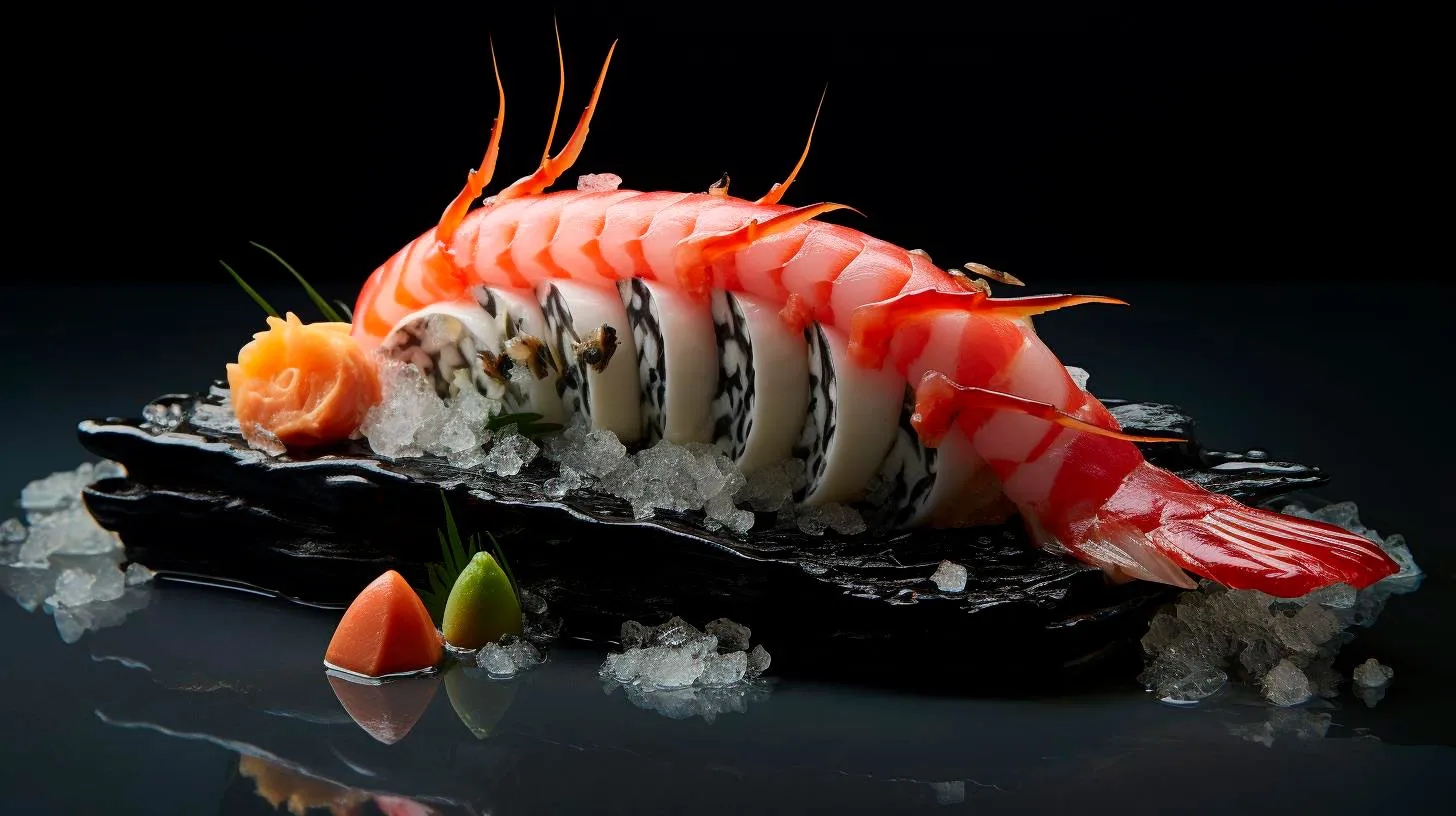Creative Plant-Based Sashimi Redefining Flavor in Vegan Cuisine
In this article, we will explore the concept of plant-based sashimi, its key features, advantages, and the exciting ways it redefines flavor in vegan cuisine.
The Concept of Plant-Based Sashimi
Plant-based sashimi is a vegan adaptation of the traditional Japanese dish, which typically consists of thinly sliced raw fish. Instead of using fish, plant-based sashimi utilizes various ingredients to mimic the flavors, textures, and appearance of their seafood counterparts. These innovative creations are not only visually stunning but also deliver an incredible taste experience that can rival traditional sashimi.
Features of Plant-Based Sashimi
Plant-based sashimi offers a range of unique features that contribute to its growing popularity within the vegan community and even among non-vegans who are curious to explore new flavors:
- Flavorful and satisfying: Despite being fish-free, plant-based sashimi boasts a harmonious blend of flavors and textures that satisfy even the most discerning palates.
- Artistic presentation: Plant-based sashimi is often presented with meticulous attention to detail, providing an aesthetically pleasing dining experience.
- Diverse ingredient options: From marinated watermelon and carrots to tofu and konjac, plant-based sashimi offers a wide variety of ingredient choices to suit different tastes and dietary preferences.
- Health-conscious alternative: Plant-based sashimi is low in saturated fats, rich in vitamins and minerals, and contains no cholesterol, making it a healthier option for those concerned about their diet.
Advantages of Plant-Based Sashimi
Plant-based sashimi brings a multitude of advantages for both vegans and non-vegans, making it a remarkable addition to the culinary world:
- Sustainability: By eliminating the use of fish, plant-based sashimi helps reduce overfishing and supports a more sustainable approach to food consumption.
- Animal-friendly: Choosing plant-based sashimi means opting for a cruelty-free dining experience that aligns with ethical values and reduces harm to marine wildlife.
- Accessibility: Plant-based sashimi provides an accessible option for those with dietary restrictions, including vegetarians, vegans, and individuals with seafood allergies.
- Creative culinary experiences: Chefs and food enthusiasts are constantly experimenting with new ingredients and techniques to create exciting plant-based sashimi dishes, elevating the culinary experience.
Plant-Based Sashimi: Redefining Flavor in Vegan Cuisine
With its unique blend of flavors and textures, plant-based sashimi is redefining the culinary landscape of vegan cuisine. Here are some key takeaways that highlight how it achieves this:
- Transforming plant-based ingredients: Plant-based sashimi showcases the versatility of ingredients such as watermelon, carrots, and seaweed, transforming them into delectable, fish-like delicacies.
- Pioneering umami flavors: Umami, the savory taste often associated with meat and seafood, is skillfully replicated in plant-based sashimi using ingredients and flavor profiles that awaken the taste buds.
- Expanding culinary boundaries: Plant-based sashimi pushes the boundaries of traditional cuisine, offering a whole new world of creative and exciting possibilities for vegan cooking.
- Changing perceptions: By challenging conventional flavor norms, plant-based sashimi is reshaping people’s perceptions of vegan food, proving that plant-based cuisine can be as flavorful and satisfying as its animal-based counterparts.
As the demand for plant-based options continues to rise, creative plant-based sashimi is carving a prominent place in the vegan food scene. Its ability to redefine flavor, present stunning dishes, and offer a sustainable and ethical dining experience gives it an edge over traditional sashimi. So, whether you’re vegan, vegetarian, or simply curious about exploring new tastes, plant-based sashimi offers an unforgettable culinary adventure that is sure to delight even the most discerning food lover.
Exploring the Art of Vegan Sushi: A Delightful Twist on Tradition
However, with the rising popularity of plant-based diets, vegan sushi has emerged as a delightful twist on this revered culinary art form. By using innovative ingredients and creative techniques, vegan sushi offers a sustainable and delicious alternative to traditional sushi.
The Rise of Vegan Sushi
The global demand for plant-based foods has been growing steadily, with an increasing number of people embracing vegetarian and vegan lifestyles for various reasons such as health, animal welfare, and environmental sustainability. As a result, vegan sushi has gained significant popularity, catering to the dietary preferences and beliefs of individuals worldwide.
Key Statistics:
- In 2019, the global vegan food market was valued at $14.2 billion, and it is projected to reach $31.4 billion by 2026.
- Between 2014 and 2019, there was a 600% increase in the number of people identifying as vegans in the United States alone.
- The demand for vegan sushi has surged by 200% in the last five years.
Innovative Ingredients in Vegan Sushi
Creating vegan sushi involves exploring unique ingredients and flavors to replicate the taste and texture of fish-based sushi. By incorporating plant-based alternatives, sushi enthusiasts can enjoy the essence of traditional sushi while maintaining their dietary choices.
Here are some innovative ingredients commonly used in vegan sushi:
- Vegetables: Carrots, cucumbers, avocado, bell peppers, and radish are popular choices for adding crunch and freshness to vegan sushi rolls.
- Fruit: Mango, pineapple, and strawberry add a subtle sweetness to complement the savory taste of vegan sushi.
- Plant-based Protein: Ingredients like tofu, tempeh, and seitan provide a protein-rich substitute for fish in vegan sushi.
- Seaweed Alternatives: Nori, the traditional seaweed wrapper, can be replaced with soy paper or thinly sliced vegetables for a unique twist.
Creative Techniques in Vegan Sushi
Alongside innovative ingredients, creative techniques play a significant role in elevating the art of vegan sushi. Chefs and home cooks alike have experimented with various methods to enhance flavors and textures, resulting in visually stunning and delicious plant-based sushi creations.
Here are some creative techniques used in vegan sushi:
- Vegetable “Fish” Fillets: Marinating and grilling thinly sliced vegetables, such as eggplant or king oyster mushrooms, can mimic the texture and taste of fish.
- Seed-Based “Caviar”: Using chia seeds or vegan fish roe substitutes provides a delightful burst of texture and flavor.
- Colorful Vegetable Rice: Infusing rice with vibrant colors by using ingredients like beetroot or turmeric enhances the aesthetic appeal of vegan sushi rolls.
- Sweet Potato “Tempura”: Baking or frying sweet potato slices can mimic the light and crispy texture of traditional tempura, adding a satisfying contrast to sushi rolls.
Key Takeaways
Exploring the art of vegan sushi opens up a world of creativity and flavors for those seeking a plant-based alternative to traditional sushi. With the demand for vegan food on the rise, vegan sushi provides an excellent opportunity to indulge in a delicious and sustainable dining experience.
Key takeaways include:
- Vegan sushi offers a sustainable and delicious alternative to traditional sushi.
- The global demand for vegan food is growing rapidly, with the vegan food market projected to reach $31.4 billion by 2026.
- Ingredients such as vegetables, fruit, plant-based protein, and seaweed alternatives are commonly used in vegan sushi.
- Creative techniques like vegetable “fish” fillets, seed-based “caviar,” and colorful vegetable rice add innovation and visual appeal to vegan sushi.
Whether you are a vegan, vegetarian, or simply looking to explore new culinary horizons, vegan sushi is an art form that continues to captivate and delight. Embrace the creativity, savor the flavors, and enjoy this delightful twist on tradition.
Breaking Down Barriers: The Rise of Vegan-Friendly Sushi
In this article, we will explore the reasons behind the surge in vegan-friendly sushi, its benefits, and how sushi restaurants are catering to this growing trend.
The Surge in Vegan-Friendly Sushi
Over the past decade, there has been a significant shift towards plant-based diets worldwide. Veganism, in particular, has gained momentum, with more and more people adopting this lifestyle for various reasons, including health, environmental concerns, and animal welfare. As a result, the demand for vegan-friendly options in restaurants has skyrocketed.
Sushi, with its delicate flavors and artful presentation, was previously seen as off-limits for vegans due to its reliance on fish and seafood. However, innovative chefs and sushi restaurants have risen to the challenge, creating plant-based alternatives that mimic the taste, texture, and aesthetic of traditional sushi.
The Benefits of Vegan-Friendly Sushi
Vegan-friendly sushi offers several benefits that make it an attractive choice for both vegans and non-vegans:
- Healthier Option: Vegan sushi is typically lower in calories, saturated fats, and cholesterol compared to its animal-based counterpart. It often includes nutrient-rich ingredients like avocado, cucumber, tofu, and various vegetables that provide a wide range of vitamins and minerals.
- Environmental Sustainability: Commercial fishing practices have had a significant impact on marine ecosystems. By opting for plant-based sushi, individuals contribute to reducing overfishing and the overall environmental footprint associated with conventional sushi production.
- Inclusive Dining Experience: Offering vegan-friendly sushi ensures that sushi restaurants can accommodate a wider range of dietary preferences and restrictions, making their menus more inclusive and appealing to a diverse customer base.
Catering to the Vegan Trend
Sushi restaurants have been quick to recognize the growing demand for vegan-friendly options and adapt their menus accordingly. To cater to the vegan trend, restaurants are employing various strategies:
- Plant-Based Substitutes: Chefs are using creative plant-based substitutes for fish, such as marinated tofu, mushrooms, and even fruits like watermelon or tomato, to replicate the texture and flavor of traditional sushi.
- Expanded Vegetable Selection: Restaurants are offering a wide range of fresh and cooked vegetables as fillings and toppings for sushi rolls, broadening the variety and visual appeal of vegan options.
- Specialty Vegan Rolls: Vegan-centric sushi rolls are becoming a common sight on menus, showcasing unique combinations of ingredients and flavors specifically designed for plant-based diners.
By embracing these innovative approaches, sushi restaurants are not only meeting the demand for vegan-friendly options but also challenging the perception that sushi is limited to fish and seafood.
Key Takeaways
- Vegan-friendly sushi is gaining popularity due to the rise of veganism and the demand for plant-based options in the food industry.
- Vegan-friendly sushi offers health benefits, environmental sustainability, and inclusive dining experiences.
- Sushi restaurants are adapting to the vegan trend by using plant-based substitutes, expanding vegetable selections, and introducing specialty vegan rolls.
The rise of vegan-friendly sushi signifies a positive step towards a more inclusive and sustainable food culture. As more people embrace plant-based diets, the demand for vegan options across all cuisines will continue to grow. Sushi restaurants that embrace this trend and offer innovative vegan-friendly alternatives are breaking down barriers and attracting a wider customer base. So, whether you follow a vegan diet or simply want to explore new culinary experiences, give vegan-friendly sushi a try and enjoy its flavorful and compassionate twist on this beloved Japanese classic.
The Future is Green: How Vegan Sushi is Revolutionizing the Dining Experience
Traditionally known for its focus on seafood, sushi is now embracing plant-based ingredients to create a whole new experience for sushi lovers. Enter vegan sushi – a delicious and sustainable culinary innovation that is revolutionizing the dining experience. Let’s explore how vegan sushi is shaping the future of the food industry.
The Rise of Vegan Sushi
Vegan sushi is a plant-based alternative to traditional fish sushi. It swaps out seafood for a variety of innovative ingredients that mimic the textures and flavors associated with sushi. This revolution is not only driven by the growing demand for vegan options but also by the desire to protect our oceans and reduce overfishing. With a myriad of eco-conscious consumers embracing plant-based diets, vegan sushi offers a guilt-free and sustainable alternative.
Notable Features of Vegan Sushi:
- Plant-based ingredients: Vegan sushi includes various plant-based alternatives such as tofu, tempeh, mushrooms, and even fruits and vegetables.
- Creative flavor combinations: Vegan sushi takes creativity to the next level with unique flavor combinations that can rival traditional sushi.
- Health benefits: By eliminating fish and seafood, vegan sushi reduces the intake of mercury and harmful toxins that can be found in seafood.
- Eco-friendly: Vegan sushi helps to conserve marine life and reduce the carbon footprint associated with traditional sushi.
The Advantages of Vegan Sushi
Vegan sushi offers several advantages that make it an appealing option for both vegans and non-vegans alike:
- Expanded dietary choices: Vegan sushi provides a new and exciting culinary experience for those with dietary restrictions or preferences.
- Increased accessibility: With the popularity of veganism on the rise, more restaurants and sushi bars are adding vegan options to their menus, making it easier for people to enjoy this innovative cuisine.
- Improved sustainability: Choosing vegan sushi means taking a step towards a more sustainable future. By reducing our reliance on fish, we can help preserve the fragile ocean ecosystems.
- Health-conscious: Vegan sushi is a lighter and healthier alternative as it is typically low in saturated fats and cholesterol while being rich in essential vitamins and minerals.
Key Takeaways
Vegan sushi is not just a passing trend; it represents a significant shift towards a more sustainable and inclusive dining experience. By embracing plant-based ingredients and creative flavors, this innovative cuisine is challenging traditional notions of sushi. Its advantages, such as expanded dietary choices, increased accessibility, and improved sustainability, make it an appealing option for those seeking a healthier and more environmentally conscious lifestyle. As the demand for vegan options continues to grow, we can expect to see even more exciting developments in the world of vegan sushi, paving the way for a greener future.


